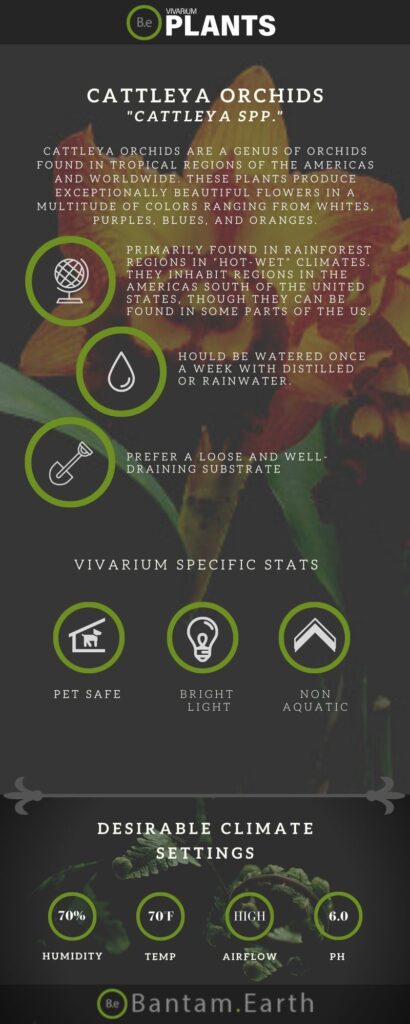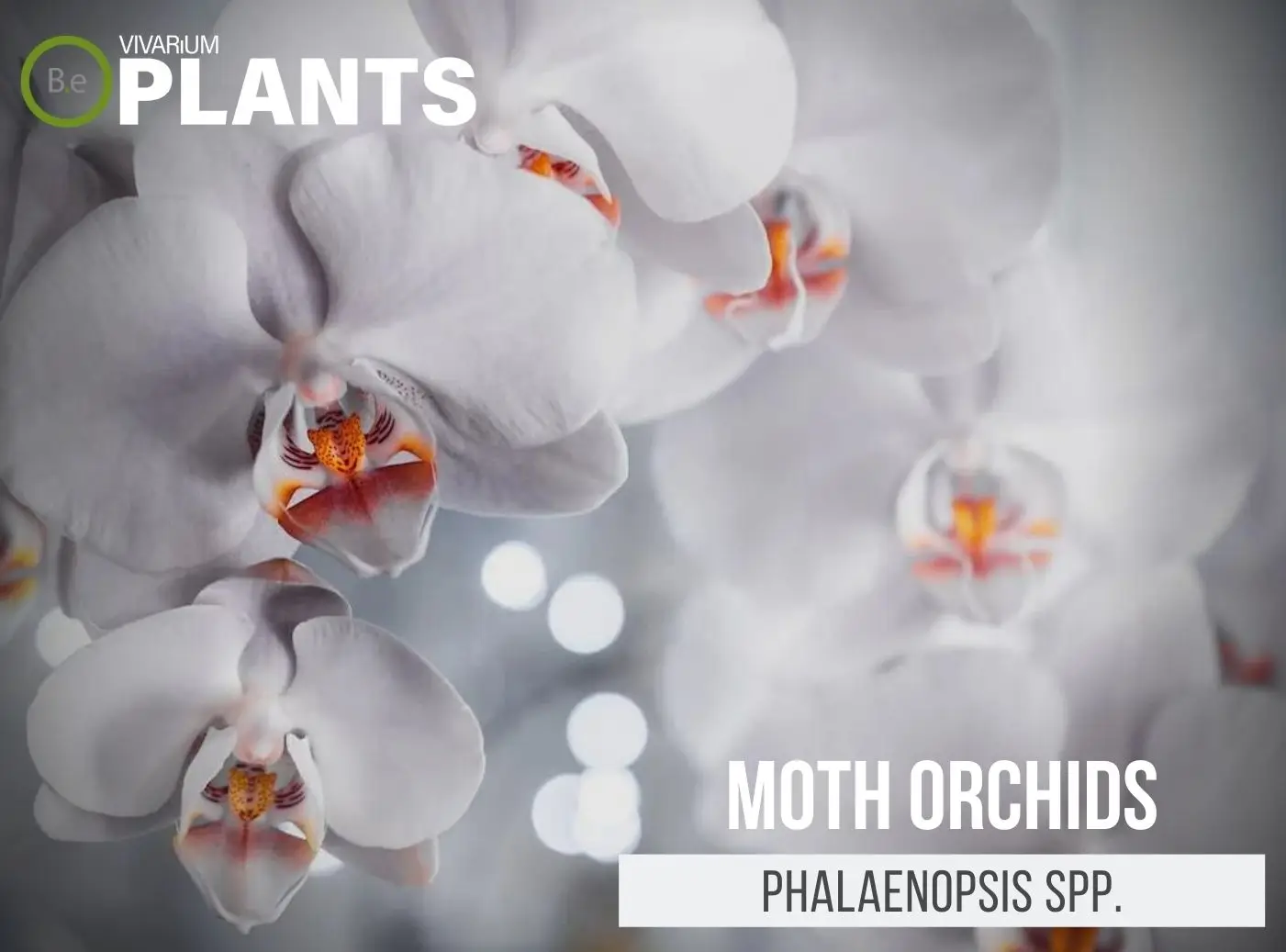Cattleya orchids are some of the most iconic plants in the orchid family, known for their vibrant colors and captivating appearances.
If you‘re looking for a beautiful and easy–to–care–for terrarium orchid, then consider the Cattleya.
These orchids are a popular choice for beginners, beautiful enough for experienced terra–keepers, and ideally suited to the moist, humid environment inside a terrarium.
In this article, you‘ll learn everything you need to know about how to properly care for your Cattleya orchid, as well as things to consider when creating the perfect terrarium environment to ensure its growth and survival.
| Quick Stats: | |
|---|---|
| Scientific Name | Cattleya spp. |
| Common Name | Cattleya Orchids |
| Family Name | Orchidaceae |
| Habitat | Tropical Epiphytes |
| Temperature | 65 to 80°F |
| Height | 8 to 14 inches |
| pH | 5.5 to 6.5 |
| Lighting | Bright, Indirect |
What Are Cattleya Orchids?
Cattleya orchids are a genus of orchids found in tropical regions of the Americas and worldwide.
These plants produce exceptionally beautiful flowers in a multitude of colors ranging from whites, purples, blues, and oranges and are often used for corsages.
Cattleya orchids have thick, fleshy pseudobulbs that grow from rhizomes and can reach heights of 8 to 14 inches.


Cattleya Orchids Facts
Cattleya orchids are popular amongst vivarium hobbyists and can make great additions to an enclosure with the right setup.
The orchids are usually sterile and receive the nutrients they need directly from the air.
This is a great plus for orchid keepers, as no fertilizers are necessary.
Cattleya orchids come in a variety of colors, sizes, and forms, so you can choose one to fit your own style of enclosure.
Description
Cattleya orchid plants are divided into two different parts: the pseudobulb and the inflorescence.
The pseudobulb is a thick and fleshy stem that grows from the underground rhizomes, and the tops of these stems are typically where the flowers grow.
The inflorescence is the flowering section of the orchid and consists of anywhere from one to six flowers.
The flower itself is made up of three sepals, three petals, and a column with a stamen and pollen sac in the center.
Habitat
Cattleya orchids are primarily found in rainforest regions in “hot-wet” climates.
They inhabit regions in the Americas south of the United States, though they can be found in some parts of the US.
They typically live in the canopy area of the forest, where they get lots of sunlight, but not too much direct sun.
pH Preference
Cattleya orchids generally prefer a slightly acidic soil pH range of 5.5-6.5.
Maintaining this range of pH will ensure that your orchid is getting adequate nutrients and that there’s no buildup of toxins in the soil.
It’s important to test your soil pH on a regular basis to ensure that your orchid stays healthy.
Vivarium Type
Cattleya orchid plants are best suited to and thrive in warm, humid environments, making them an ideal terrarium plant.
To create the perfect environment, you should aim for a terrarium that maintains a temperature of between 70–90°F, with a humidity of 50–70%.
Furthermore, an open mesh lid is best for air circulation, as well as good drainage with an enclosure filled with heavy soil, moss, and dead wood.
Vivarium Placement
Cattleya orchid plants can thrive in vivariums if situated correctly.
These fantastic plants are epiphytes and should be placed high up near the top of the enclosure and secured in place with a thin layer of moss or substrate.
This will help the orchid stay upright and give it the airflow and light it needs to thrive.
Substrate
Cattleya orchids prefer a loose and well-draining substrate.
Substrates such as sphagnum moss, fir bark mixes, and perlite, are all excellent choices for these plants.
You should also make sure that your substrate is slightly acidic, as this will help the orchid root into the substrate.
Lighting
Cattleya orchids prefer bright, indirect light. Vivariums that are made with glass or clear acrylic with extra ventilation can usually provide enough light, as long as they are kept out of direct sunlight.
If possible, it’s a good idea to add some terrarium lighting such as LED or fluorescent lights to give the orchid an extra boost of light.
Buy Cattleya Orchids
When shopping for orchids, expect a few key indicators you are buying the best quality plant.
The plant should be pest free.
The source of the orchid will more than likely not be in bloom so don’t worry if it arrives without flowers.
Click the image below to find out more about the current price and other relative info:
Cattleya Orchids Care and Propagation
Cattleya orchids are fairly easy to care for and propagate.
They do best when provided with adequate humidity and watered regularly with distilled or rainwater.
They also benefit from being fertilized monthly with a low-strength fertilizer and allowed to dry out between waterings.
When propagating, wait until the first pseudobulb has produced two new pseudobulbs before dividing the clump in two and replanting.
You can also propagate these plants via seed, but this method is much less successful.
How to grow
When growing Cattleya orchids, it’s important to provide them with plenty of humidity and water.
Vivariums that are kept too dry can lead to the orchid’s leaves drying out and the plant eventually dying.
You should also make sure that your vivarium is adequately ventilated as this will help keep the orchid’s leaves moist and reduce the risk of disease.
Watering
Cattleya orchids should be watered once a week with distilled or rainwater.
You should avoid fertilized water for the most part and be careful not to over-water, as this can lead to the orchid’s leaves drying out.
Watering should be done in the morning so the orchid can take in the moisture before the light begins to fade in the evening.
Plants Similar To Cattleya Orchids
Adding diversity to an enclosure is key to an aesthetically pleasing enclosure.
Try mixing up the look of your terrarium with different flora that can easily co-exist in the same types of environment.
Furthermore, if for some reason you find this orchid hard to acquire or would like to consider something similar to this terrarium plant…
Here are some other plants you might find may do well with or in the place of cattleya spp.:
Conclusion
Cattleya orchids are perfect mid-level plants to add to your terrarium setup.
They have beautiful flowers that can really add a decorative look to any enclosure.
With the right setup and proper care, these orchids can thrive in a vivarium and are not too difficult to care for.
Just make sure to provide them with plenty of humidity and light, and you should have no trouble keeping your orchid healthy and happy.
Frequently Asked Questions
Cattleya orchids typically bloom once or twice a year.
Yes, Cattleya orchids prefer humid conditions and enjoy being misted regularly. High humidity levels will help the cattleyas bloom more profusely and keep their leaves healthy.
Yes, Cattleya orchids are able to tolerate and even thrive in full sun environments. Make sure to provide adequate water and nutrients for your plants, as well as keep them in a well–ventilated area to prevent the leaves from scorching or wilting in the sun.
To get a Cattleya orchid to rebloom, give the orchid bright, indirect sunlight and keep the temperature between 65–85°F. Water the orchid every other week and fertilize it every month during its growing season. Make sure the plant has good air circulation and healthy roots. If the plant does not bloom, reduce fertilizing and more heavily water the plant.
No, Cattleya orchids are not difficult to grow, provided you give them the right amount of moisture, light and air circulation. They are among the more forgiving orchid species and a great option for beginner orchid growers.




